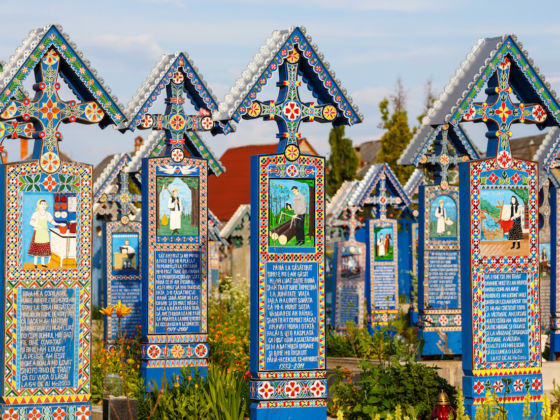Cemeteries are often on travelers’ must-see lists (and no, we aren’t being sarcastic — people really have a thing for visiting burial grounds). The prestigious Père LaChaise cemetery in Paris is always filled with curious tourists wanting to have a look the tombstones of Van Morrison, Oscar Wilde, or Edith Piaf, and the city’s catacombs count hundreds of thousands of visitors every year. The Jewish cemetery in Prague is one of the most-recommended spots to check out in the city, and the Normandy American Cemetery’s massive fields of small, white crosses attract about one million visitors each year. But, even though these world-famous cemeteries are extremely popular with visitors, they inspire little more than tragedies, loss, and sadness.

This Is the Happiest Cemetery in the World
The graveyard of the town of Săpânța in Romania is not your typical dreary cemetery. It’s not filled with cookie-cutter, grey tombstones. It’s not decorated with plastic bouquets in pewter vases, large granite crosses, and sculptures of crying angels. Instead, it’s a seemingly cheerful place where every single tombstone is vivid and fun, hence the cemetery’s moniker: Cimitriul Vesel, the Merry Cemetery.
Stan Ioan Patras, a local woodcarver, started creating grave markers for the Săpânța cemetery in 1935 until his death in 1977. Each grave marker is made of wood, stands vertically on the grave, and is topped with a pointed, tin-covered, carved roof that protects the piece from the rain. All the graves markers are painted a special blue (“Săpânța blue”) and are heavily decorated with colorful flowers, as well as both geometrical and organic motifs, making the cemetery look incredibly bright and joyful.

Photo: Danilovski/Shutterstock
But each memorial is different. Below the pointy roof is a cross, and under each cross is a colorful painting representing the deceased doing something they loved, their jobs, or at the moment of their death — cooking, sewing, drinking, having a car accident, etc. — and, under each painting, is a unique, witty epitaph in the shape of a poem that describes the person buried below. Unless you speak Romanian, deciphering these poems will prove difficult, but two examples have been provided by the area’s tourism bureau:
And Pop Toader is my name.
I used to love the clarinet
And the tuica (brandy) in my glass
As long as I lived on Earth
I kept thinking of these things:
To have something to drink and what to eat
And to play the clarinet
I was also miserable
Cause I was a widower
But for you I am singing merrily
Not the way I am singing for myself.
Another one, a little more on the funny side, reads:
Had she lived another three days
It would have been me who lied here
And she would have been the reader
There are about 800 such grave markers in the Merry Cemetery and, despite the death of Stan Ioan Patras (also buried in the cemetery, behind the church that’s just as cool as the graveyard), the tradition continues thanks to Patras’ apprentice, Dumitru Pop. But because he knows he too will end up in the Merry Cemetery (he’s got his plot reserved), he’s training the next carver/painter/poet who will take his place.

Photo: Dziewul/Shutterstock
Săpânța is located very close to the border that Romania shares with the Ukraine and is a 10-hour drive (about 360 miles) from Bucharest, the capital. The area around Săpânța is also home to eight gorgeous UNESCO World Heritage wooden churches, so the detour to this part of the country is well worth it.